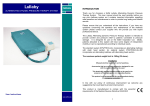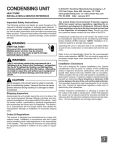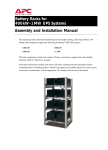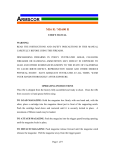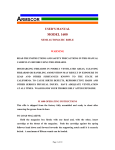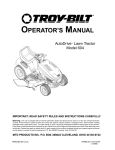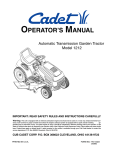Download 2100-393 - Bard Manufacturing Company
Transcript
INSTALLATION INSTRUCTIONS TEC40 ELECTRONIC CONTROLLER BARD MANUFACTURING COMPANY Bryan, Ohio 43506 Since 1914...Moving ahead, just as planned. Manual: Supersedes: File: Date: 2100-393C 2100-393B Volume III Tab 19 07-11-02 CONTENTS Shipping Damage ...................................................... 1 Figures General ..................................................................... 1 Figure 1 Control Locations ................................... 5 Theory of Operation .................................................. 1 Figure 2 Four Unit Mode ...................................... 6 With and Without Economizers Lead-Lag Change Over Time .................................... 1 Modes of Operation .................................................. 1 Installation Instructions ............................................. 3 Fire Suppression Circuit ............................................ 3 Adjustments .............................................................. 4 i Figure 3 Three Unit Mode .................................... 7 With and Without Economizers Figure 4 Two Unit Mode With Economizers ......... 8 Figure 5 Two Unit Mode Without Economizers .... 9 ** IMPORTANT ** The equipment covered in this manual is to be installed by trained, experienced service and installation technicians. Please read entire manual before proceeding. In the event of a unit(s) failure, the change over time jumper may be set to 0 days. This will prevent the TEC40 from switching lead unit to the next unit. Push the push-button to make a functional unit the lead unit if necessary. If power is lost the controller will remember which unit was the lead unit when power is reapplied. MODES OF OPERATION SHIPPING DAMAGE Upon receipt of equipment, the carton should be checked for external signs of shipping damage. If damage is found, the receiving party must contact the last carrier immediately, preferably in writing, requesting inspection by the carrier’s agent. The TEC40 has four modes of operation. 1. Four Unit Mode 2. Three Unit Mode 3. Two Unit Alternating Mode 4. Two Unit Non-Alternating Mode. STAGING DELAY PERIODS GENERAL These instructions explain the operation, installation and troubleshooting of the TEC40 controller. All internal wiring is complete. Only attach low voltage field wiring to designated terminal strips. The controller is for use with up to four (4) Bard air conditioning wall mount series units. The TEC40 is for use with units with or without economizers. It is recommended that a five (5) minute compressor time delay relay be factory or field installed in each unit. The TEC40 controller is suitable for both 50 and 60 HZ operation. THEORY OF OPERATION The controller is used to control up to four wall mount air conditioners from one thermostat. It provides total redundancy for the structure and equal wear on all units. It can be used with units with economizers but all units must be equipped alike. That is, all must have economizers or all must be without economizers. See Figure 1 for component locations. LEAD–LAG CHANGE OVER TIME The lead- lag change over time period is user selectable. Time periods available are 0, 1, 3, 7, 14 and 28 days. Once every time period the lead unit will be advanced to the next unit providing equal wear on the units. For timer speed up, push and hold the change lead unit push-button for one second. Timer speed up is supplied for ease of trouble shooting. Lead unit cycles between all 4 units in four unit mode; between 1, 2 and 3 in three unit mode; and between units 1 and 2 in both two unit modes. The following delays are built in for both cooling and heating: stage 1 – 0 seconds; stage 2 – 10 seconds; stage 3 – 15 seconds; and stage 4 – 20 seconds. The delays are active anytime there is a power interruption or the controller ON–OFF switch is exercised. FOUR UNIT MODE In four unit mode the TEC40 will control four airconditioners with or without economizers. Make connections per Figure 2 on Page 6. Sequence of Operation – Cooling First stage cooling set point is determined by the position of the cooling set point potentiometer. On a call for first stage cooling, the blower and either economizer or compressor of the lead unit is energized. The enthalpy control on the economizer will make the decision as to which is energized. If not equipped with economizers the compressor will energize. First stage cooling LED will light. Second stage cooling set point is 2.0 degrees warmer than first stag cooling set point. On a call for second stage cooling, the blower and either economizer of compressor of the next unit is energized. The enthalpy control on the economizer will make the decision as to which is energized. If not equipped with economizer the compressor will energize. Second stage cooling LED will light. Third stage cooling set point is 2.0 degrees warmer than second stage cooling set point. On a call for third stage cooling, the blower and either economizer is energized. The enthalpy control on the economizer will make the decision as to which is energized. If not equipped with economizer the compressor will energize. Third stage cooling LED will light. Manual 2100-393 Page 1 Fourth stage cooling set point is 2.0 degrees warmer than third stage cooling set point. On a call for fourth stage cooling, the blower and either economizer or compressor of the next unit is energized. The enthalpy control on the economizer will make the decision as to which is energized. If not equipped with economizer the compressor will energize. Fourth stage cooling LED will light. Sequence of Operation – Heating First stage heating set point is determined by subtracting the dead band setting from cooling set point setting. For example, if the cooling set point is 74 degrees and the dead band adjustment is set at 4 degrees the heating set point is 70 degrees. On a call for first stage heating, the blower and electric heat of the lead unit is energized. First stage heating LED will light. Second stage heating set point is 2.0 degrees colder than first stage heating set point. On a call for second stage heating, the blower and electric heat of the next unit is energized. Second stage heating LED will light. Third stage heating set point is 2.0 degrees colder than second stage heating set point. On a call for third stage heating, the blower and electric heat of the next unit is energized. Third stage heating LED will light. Fourth stage heating et point is 2.0 degrees colder than third stage heating set point. On a call for fourth stage heating, the blower and electric heat of the next unit is energized. Fourth stage heating LED will light. THREE UNIT MODE In three unit mode the TEC40 will control three air conditioners with or without economizers. Make connections per Figure 3 on Page 7. Sequence of Operation The cooling and heating sequence of operation are the same as four unit mode except that the fourth stage heating or cooling is not available. TWO UNIT NON-ALTERNATING MODE In two unit non-alternating mode the TEC40 will control two air conditioners with two speed or dual compressors. Make connections per Figure 5 on Page 9. Sequence of Operation – Cooling First stage cooling set point is determined by the position of the cooling set point potentiometer. On a call for first stage cooling, the blower and low speed or first compressor of the lead unit is energized. First stage cooling LED will light. Manual 2100-393 Page 2 Second stage cooling set point is 2.0 degrees warmer than first stage cooling set point. On a call for second stage cooling, the high speed or second compressor of the lead unit will energize. Second stage cooling LED will light. Third stage cooling set point is 2.0 degrees warmer than second stage cooling set point. On a call for third stage cooling the blower and low speed or first compressor of the lag unit will energize. Third stage cooling LED will light. Fourth stage cooling set point is 2.0 degrees warmer than third stage cooling set point. On a call for fourth stage cooling , the high speed or second compressor of the lag unit will energize. Fourth stage cooling LED will light. Sequence of Operation – Heating First stage heating set point is determined by subtracting the dead bank setting from cooling set point setting. For example, if the cooling set point is 74 degrees and the dead band adjustment is set at 4 degrees the heating set point is 70 degrees. On a call for first stage heating, the blower and electric heat of the lead unit is energized. First stage heating LED will light. Second stage heating set point is 2.0 degrees colder than first stage heating set point. On a call for second stage heating, the second electric heat (if equipped) of the lead unit is energized. Second stage heating LED will light. Third stage heating set point is 2.0 degrees colder than second stage heating set point. On a call for third stage heating, the blower and electric heat of the lag unit is energized. Third stage heating LED will light. Fourth stage heating set point is 2.0 degrees colder than third stage heating set point. On a call for fourth stage heating, the second electric heat (if equipped) of the lag unit is energized. Fourth stage heating LED will light TWO UNIT ALTERNATING MODE In two unit alternating mode the TEC40 will control two air conditioners with two speed or dual compressor or two air conditioners with economizers with full redundancy. Make connections per Figure 4 on Page 8. Sequence of Operation – Cooling with Economizers First stage cooling set point is determined by the position of the cooling set point potentiometer. On a call for first stage cooling, the blower and either economizer or compressor of the lead unit is energized. The enthalpy control on the economizer will make the decision as to which is energized. First stage cooling LED will light. Second stage cooling set point is 2.0 degrees warmer than first stage cooling set point. On a call for second stage cooling, the blower and either economizer or compressor of the lag unit is energized. The enthalpy control on the economizer will make the decision as to which is energized. Second stage cooling LED will light. Third stage cooling set point is 2.0 degrees warmer than second stage cooling set point. On a call for third stage cooling, the compressor of the lead unit will energize and the economizer will return to minimum position if open. Third stage cooling LED will light. Fourth stage cooling set point is 2.0 degrees warmer than third stage cooling set point. On a call for fourth stage cooling, the compressor of the lag unit will energized and the economizer will return to minimum position if open. Fourth stage cooling LED will light. Sequence of Operation – Heating First stage heating set point is determined by subtracting the dead and setting from cooling set point setting. For example, if the cooling set point is 74 degrees and the dead band adjustment is set at 4 degrees the heating set point is 70 degrees. On a call for first stage heating, the blower and electric heat of the lead unit is energized. First stage heating LED will light. Second stage heating set point is 2.0 degrees colder than first stage heating set point. On a call for second stage heating, the electric heat of the lag unit is energized. Second stage heating LED will light. Third stage heating set point is 2.0 degrees colder than second stage heating set point. On a call for third stage heating, the second electric heat (if equipped) of the lead unit is energized. Third stage heating LED will light. Fourth stage heating set point is 2.0 degrees colder than third stage heating set point. On a call for fourth stage heating, the second electric heat (if equipped) of the lag unit is energized. Fourth stage heating LED will light. NSTALLATION INSTRUCTIONS MOUNTING Included in the controller carton is the controller and installation instructions. The controller should be installed on a vertical wall approximately four (4) feet above the floor away from drafts and outside doors or windows. Four (4) mounting holes are provided for mounting to the wall, and holes for conduit connections are provided in both the base, side and top of the controller. The controller should not be mounted directly to a block wall; space away from wall with insulation or plywood. Once mounted, slide the thermistor sensor down into the fitting on the bottom of the TEC40. Position the sensor so that 15/16 inch is protruding from the bottom of the fitting. Tighten the fitting to hold the sensor in position. LOW VOLTAGE FIELD WIRING The TEC40 is powered from the air conditioners that it is controlling, 24 VAC, 50/60 HZ, low voltage only. Circuitry in the TEC40 isolate the power supplies of all connected air conditioners so that no back feeds or phasing problems can occur. Additionally if one or more air conditioners loose power the TEC40 and the other air conditioners are unaffected and will continue to operate normally. Connect the low voltage field wiring from each unit per the low voltage field wiring diagrams in Figure 2, 3, 4 or 5 depending on the mode of operation desired. FIRE SUPPRESSION CIRCUIT To disable the TEC40 and shut down all air conditioners, terminal F1 and F2 may be used. The F1 and F2 terminals must be jumpered together for normal operation. A normally closed set of contacts may be connected across the terminals and the factory jumper removed for use with a field installed fire suppression system. The contacts must open if a fire is detected. Contacts should be rated for pilot duty operation at 2 amp 24 VAC minimum. IMPORTANT NOTE: Bard models employ an electronic blower control that has a 60-second blower off-delay. In order to have immediate shutdown of the blower motor in addition to disabling the run function of the air conditions will require a simple wiring modification at the blower control located in the electrical control panel of the air conditioners being controlled by the lead/lag controller. To eliminate the 60- second blower off-delay disconnect and isolate the wire that is factory connected to the “R” terminal to the electronic blower control, and then connect a jumper from the “G” terminal on the blower control to the “R” terminal on the blower control. The electronic blower control will now function as an onoff relay with no off-delay, and the blower motor will stop running immediately when the F1-F2 fire suppression circuit is activated (opened). Manual 2100-393 Page 3 ADJUSTMENTS See Figure 1. COOLING SET POINT Set the cooling set point in degrees C° or F° as indicated on the front of the TEC40. DEAD BAND The dead band is the span between heating set point and cooling set point where no heating or cooling takes place. The cooling set point minus the dead band equals the heating set point. Adjustable from 4° to 20° F. If the jumper is set to 7 days (or other selected choice), units will rotate upwards: first to second, second to third, third to fourth, and fourth to first place. If connected for three units then three will go to first, and fourth position is ignored. The 0 day position is supplied in the event of a unit failure or if only one air conditioner is used with the TEC40. If the unit needs to run for a time and not switch to the lag unit, set the jumper to “0” and push the lead change push-button to make the functional or single unit the lead unit. When the jumper is in the 0 position the lead unit will never switch. TEST MODE JUMPER – UNDER COVER Turn the potentiometer fully counter clockwise for 4° dead band. Turn fully clockwise for 20° dead band. The arrow on top of the potentiometer does not indicate dead band setting. There is a test mode to accelerate the timing circuit from days to seconds. For example, if the timing selection jumper plug were set to the 7 day position, then utilizing the test mode feature the lead unit would advance in 7 seconds. LEAD CHANGE PUSH-BUTTON To use the test feature take the following steps: Pushing the lead change push-button will immediately change the lead unit to the lag unit. It also resets the lead/lag change over timer to zero and restarts the selected timing period. 1. Turn the on/off switch to OFF. ON/OFF SWITCH – UNDER COVER This disables the TEC40. This switch must be ON for any heating or cooling to operate. NOTE: Whenever the on/off switch is first turned ON, all 4 red LED’s for lead unit indication will flash 4 or 5 times as the controller sequences itself, and then will revert to whichever unit was lead when on/off switch was turned OFF. 2. Place the jumper across the test mode pins. 3. Turn the on/off switch to ON. 4. The lead unit will now advance in upward sequence through the enabled unit positions. 5. To stop the accelerated sequence turn the on/off switch to OFF, remove the jumper, and then turn the on/off switch back ON. 6. After the 4 red LED’s stop flashing the lead unit may be the one indicated at the time the on/off switch was turned OFF or it may be the next one up, depending on where the timer was in the accelerated sequence when switch was turned OFF. CHANGING SELECTABLE FEATURES To change any selectable feature turn on/off switch OFF. Change jumpers as necessary and turn switch ON. Jumper changes do not take effect unless on/off switch is turned OFF, jumper plug moved, and on/off switch turned back ON. CHANGE OVER TIME JUMPER – UNDER COVER The change over period for the sequence can be adjusted to 0, 1, 3, 7, 14 or 28 days. Manual 2100-393 Page 4 OPERATION MODE JUMPER – UNDER COVER Position jumper across pins 4 for four unit mode. Position jumper across pins 3 for three unit mode. Position jumper across pins 2 for two unit nonalternating mode. Remove jumper for two unit alternating mode. CONTINUOUS BLOWER JUMPER – UNDER COVER Position jumper across pins for continuous blower on the lead unit. Remove jumper to have the lead unit blower cycle with the compressor. FIGURE 1 CONTROL LOCATIONS 7960-477 Manual 2100-393 Page 5 Manual 2100-393 Page 6 FIGURE 2 FOUR UNIT MODE WITH ECONOMIZERS FOUR UNIT MODE WITHOUT ECONOMIZERS FIGURE 3 THREE UNIT MODE WITH ECONOMIZERS THREE UNIT MODE WITHOUT ECONOMIZERS Manual 2100-393 Page 7 Manual 2100-393 Page 8 FIGURE 4 TWO UNIT MODE WITH ECONOMIZERS MIS-1657A FIGURE 5 TWO UNIT MODE WITHOUT ECONOMIZERS Manual 2100-393 Page 9 MIS-1658












